A fishing kayak is a specialized vessel designed for both recreational angling and competitive fishing, featuring sleek designs, lightweight construction, and advanced features like GPS tracking. Speed in these kayaks is a game-changer, reducing fatigue, increasing catch rates, and providing access to remote areas. Key considerations for top speed include hull shape, lightweight materials, efficient oars, and ergonomic design. Choosing the right materials balances stability with agility, while hydrodynamic shapes and strategic equipment placement enhance efficiency. Mastering paddling technique and understanding watercraft dynamics further improve performance. Rigorous testing ensures consistent speed under diverse conditions, making modern fishing kayaks popular for both competitive and recreational anglers seeking exciting, efficient fishing experiences.
In the dynamic world of water sports, the fishing kayak has emerged as a versatile vessel, offering both recreation and sustenance. “Streamlined for Speed” delves into the art and science of enhancing kayaking performance. We explore why speed matters, from increased efficiency to enhanced hunting success. Uncovering key components, material choices, and design intricacies, this guide optimizes your fishing kayak’s potential. Learn about precise paddle techniques, watercraft dynamics, and real-world applications, transforming your next adventure on the water.
Understanding the Fishing Kayak: Unlocking its Potential
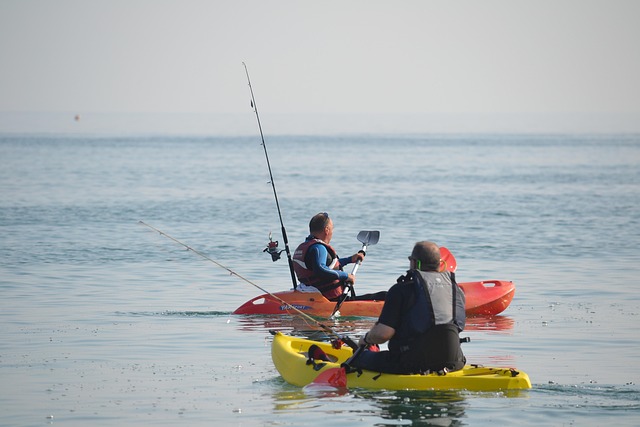
The fishing kayak is a versatile and specialized vessel designed for both recreational angling and competitive fishing. Its sleek design, equipped with features like a sit-on deck, rod holders, and storage compartments, allows anglers to maneuver effortlessly through water bodies. Understanding the unique capabilities of a fishing kayak is key to unlocking its full potential. These kayaks offer stability, enabling users to cast lines accurately even in choppy conditions.
With their lightweight construction, they are easy to transport and launch, making them ideal for exploring various fishing spots. Anglers can access shallow waters or remote areas with ease, opening up a world of untouched fishing grounds. Moreover, many modern fishing kayaks are equipped with advanced features like GPS tracking, allowing precise navigation and the ability to mark favorite fishing haunts. This blend of tradition and technology makes the fishing kayak an indispensable tool for enthusiasts, promising efficient and enjoyable fishing experiences.
Why Speed Matters in Kayaking: Benefits and Advantages
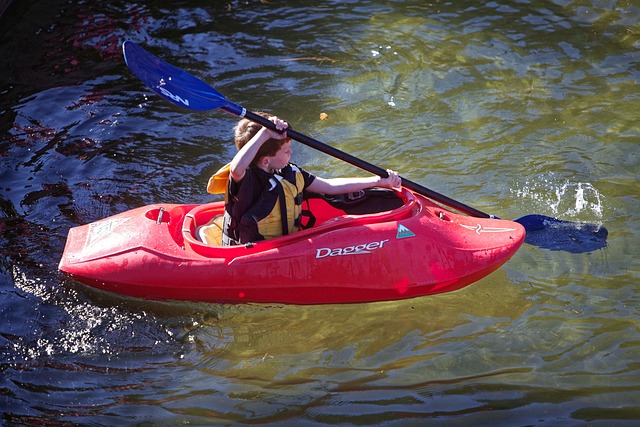
In the world of kayaking, speed is a game-changer, especially for those who utilize their kayaks for more than just leisure. For anglers, or folks who enjoy fishing from their kayaks, every second counts when chasing the perfect catch. A streamlined kayak designed for speed allows anglers to cover more water in less time, increasing their chances of locating fish. This efficiency is particularly beneficial in vast bodies of water where navigating slowly can be tiring and time-consuming.
The advantages extend beyond increased fishing success rates. Faster kayaks enable kayakers to reach remote spots quickly, providing access to exclusive fishing grounds. Moreover, the reduced time on the water means less fatigue, allowing anglers to stay focused and enjoy a more enjoyable overall experience. This is especially true for long-distance kayak trips where speed can make all the difference in terms of comfort and safety.
Key Components for a Streamlined Build

When building or optimizing a fishing kayak, several key components contribute to its streamlined design for speed. Firstly, consider the hull shape—a hydrodynamic profile reduces drag, enabling the kayak to cut through water more efficiently. Opt for materials like fiberglass or composite fabrics that offer a balance between strength and weight reduction, enhancing overall speed.
Additionally, the choice of oars plays a significant role. Lightweight yet durable oars with specific angles and designs can significantly impact paddling efficiency. A well-designed seat and pedal system also matter; adjustable seats and ergonomic pedals ensure optimal body positioning, minimizing energy wastage and maximizing speed during your fishing adventures.
Choosing the Right Materials: Weight and Durability
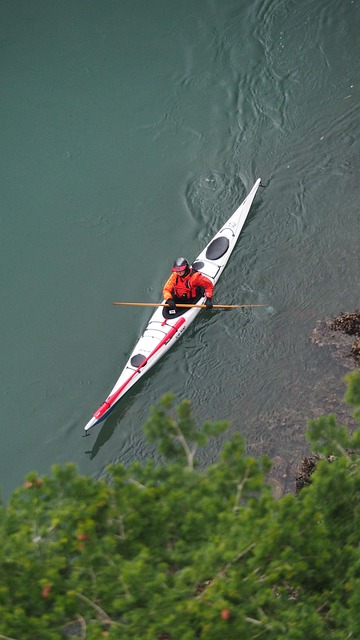
When building or selecting a fishing kayak, choosing the right materials is paramount for both performance and longevity. Heavier materials might offer more stability, but they also make your kayak slower and more cumbersome to maneuver. Conversely, lighter materials provide better speed and agility, enabling quicker turns and easier transport. The ideal material strikes a balance between weight and durability.
For instance, composite materials like carbon fiber or fiberglass are lightweight yet remarkably strong, making them popular choices for performance-oriented fishing kayaks. These materials offer excellent resistance to the elements and reduce the risk of damage during active use, ensuring your kayak remains in top condition for years to come.
Design Considerations for Maximum Efficiency
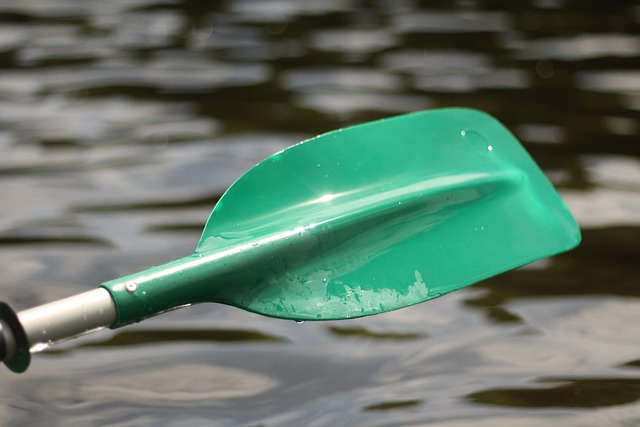
When designing a fishing kayak, maximizing efficiency is paramount. Consideration should be given to reducing weight and bulk while enhancing stability and maneuverability. A streamlined design, incorporating hydrodynamic shapes, allows for easier paddling and improved speed through water. This includes a sleek, tapered hull that minimizes drag, enabling kayakers to cover more ground with less effort.
Additionally, thoughtful placement of equipment and accessories is crucial. Strategically designed storage compartments and optimized seating positions can reduce time spent searching for gear, further enhancing the overall efficiency of the kayak. A well-designed fishing kayak combines functionality, speed, and comfort, ensuring a more productive and enjoyable experience on the water for anglers.
Propelling with Precision: Paddle Selection and Technique
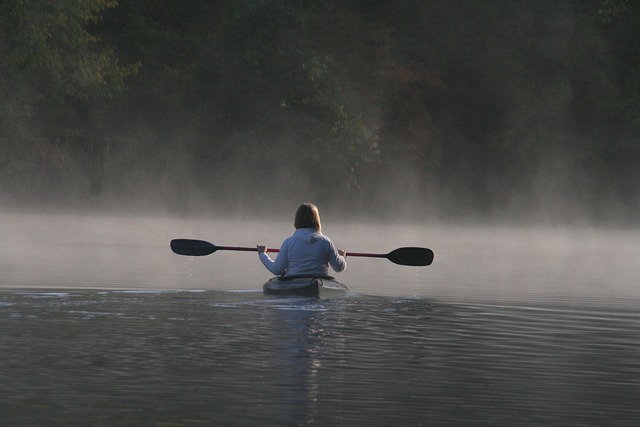
In a fishing kayak, every movement counts when it comes to efficiency and speed. Propelling with precision involves a combination of the right paddle selection and effective technique. The choice of paddle is key; for kayaking, a wider blade offers more power per stroke, enabling faster turns and smoother glides. Unlike rowing, where a longer shaft might be beneficial, fishing kayaks often excel with shorter paddles that provide better control during tight maneuvers in shallow waters.
Technique-wise, a fluid and continuous motion is ideal. Maintain a relaxed grip, keep your wrist straight, and sweep the paddle from one side to another in a smooth arc. This action ensures maximum propulsion while minimizing energy waste. Practicing regular paddling exercises can significantly improve this technique, allowing you to cover more ground with ease in your fishing kayak.
Navigating Watercraft Dynamics: Control and Maneuverability

In the realm of streamlined for speed, understanding watercraft dynamics is paramount, especially in a fishing kayak where control and maneuverability are key. Kayaks, designed for agility, allow anglers to navigate tight spaces and swiftly respond to unpredictable aquatic environments. The precision with which a kayaker can steer their vessel directly impacts the success of their fishing expedition, enabling them to access hard-to-reach areas and capitalize on fish bites.
The art of kayaking involves mastering techniques that balance speed with stability. By leveraging the interplay between water resistance, thrust, and gravity, skilled paddlers can cut through waves and currents with ease. This mastery translates into efficient travels across vast distances, ensuring anglers spend more time enjoying the outdoors and less time struggling to stay afloat—a true game-changer for fishing enthusiasts.
Testing and Refinement: Optimizing Performance
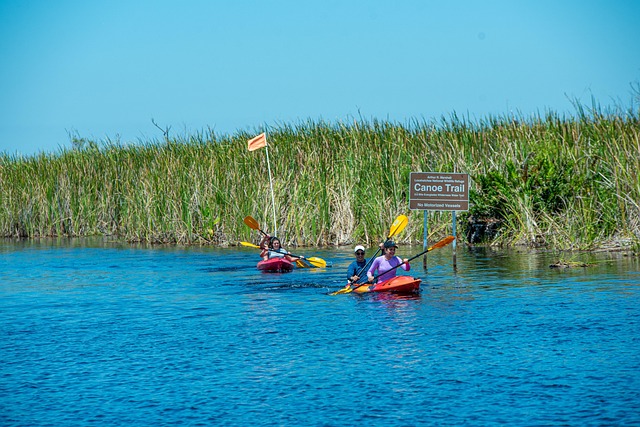
In the pursuit of speed, testing and refinement are key components for optimizing performance in a fishing kayak. Every component, from the hull design to the choice of paddling gear, plays a role in determining how swiftly and efficiently the kayak glides through the water. Rigorous testing involves putting the kayak through its paces under various conditions—different water currents, weather, and even loads (simulating the weight of equipment and catch). By meticulously recording data during these trials, manufacturers can identify areas for improvement, making adjustments to materials, shapes, or gear arrangements to enhance speed without compromising stability or maneuverability.
This iterative process of testing and refinement ensures that the final product is a streamlined fishing kayak capable of delivering top performance. It’s not just about achieving high speeds; it’s about maintaining those speeds consistently under different conditions. This dedication to refining every detail ultimately enhances the overall fishing experience, allowing kayakers to cover more ground, reach their desired locations faster, and enjoy a smoother, more efficient journey while pursuing their catch.
Real-World Applications: Scenarios for Speed Fishing Kayaks
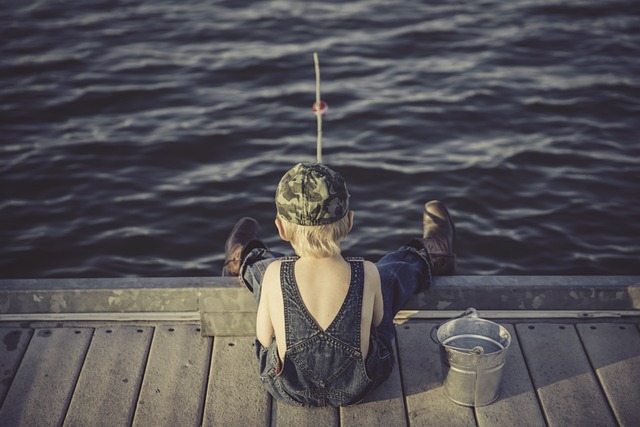
In the realm of outdoor recreation, speed fishing kayaks have emerged as a game-changer for folks who love both water sports and angling. These streamlined vessels allow enthusiasts to navigate rivers and lakes with exceptional agility, enabling them to cover more ground in less time. This is particularly beneficial in scenarios where fish are known to gather, providing anglers with increased opportunities to catch their target species.
Real-world applications of speed fishing kayaks span from competitive events where kayakers display their prowess, to leisure outings where families and friends enjoy the thrill of swift movement on calm waters. The design of these kayaks emphasizes speed and maneuverability, making them ideal for exploring hard-to-reach areas and quickly responding to the unpredictable movements of fish. Whether on a tranquil lake or a fast-flowing river, speed fishing kayaks offer an exhilarating experience that enhances the overall fishing adventure.
